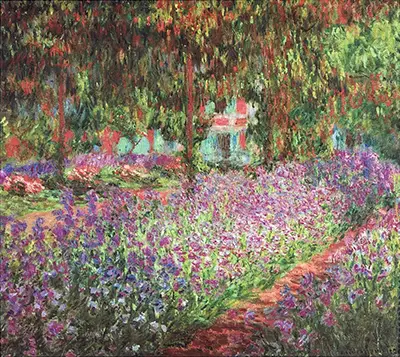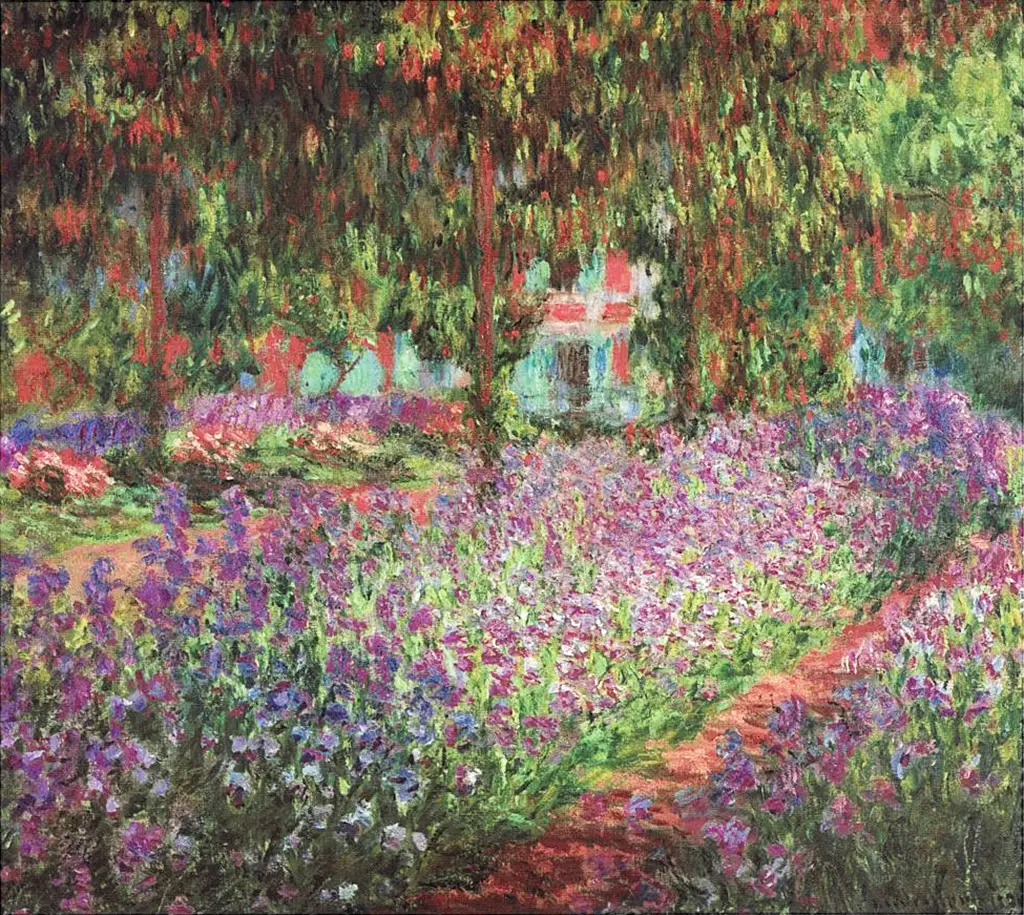For almost two decades Monet had given daily instructions to his gardener in order to construct a meticulous and unrivalled landscape where he could enjoy nature and crucially work to recreate it's infinite variations in his paintings. Monet had planted the lilies in the ponds for which he became justly famous, but also the long flowerbeds we can see in Artist's Garden at Giverny. The painting has a formality that was not present in all of Monet's work during this stage of his life.
Where in his more well known paintings of the water lilies we have come to expect a certain chaos and an absence of structure, here we see the borders of the flowerbeds create a well defined sense of order. As the lines of lilacs stretch away from the viewer so we are drawn deeper into the heart of the work, towards the shadows that lie at the far end of the garden and the house just visible behind the canopy of trees.
The sense of order is a little surprising and invites us to recognise that although Monet was clearly hugely fond of nature in all its chaotic and wild beauty, he perhaps also had some desire to bring it under control and to make it bend to his own will.
Indeed Monet suffered so many personal tragedies during his life, including the death of his mother when he was only sixteen years old and of his beloved wife Camille who died of cancer in her early thirties, one might imagine that control of this vast garden might have been a sublimated desire to exert control over nature itself. Perhaps the most striking feature of Artist's Garden at Giverny however is the extraordinary use of colour. While the deep purples of the lilacs dominate the canvas, we can see reds, golds, blues and browns spread across the work, merging into each other with a mastery that few other painters of his era could rival. There is no mistaking what we are looking at in the painting, but at the same time this is a truly great example of what made impressionism such a ground-breaking movement at the turn of the century.
The vibrancy that Monet creates through his bold use of colour and the confident brush work is such that we feel we can not only see the garden exactly as Monet saw it but that we can also hear the bees buzzing as they gather pollen and smell the rich floral scent of the lush carpet of flowers. The beating heart of the impressionist movement was about creating a work of art that spoke to all the senses, that transported the viewer to the point in time that the artist was experiencing, and in Artist's Garden at Giverny Monet has achieved this as successfully as in any of his works. As we stand and gaze into the depths of this beautiful rural idyll in northern France we can feel the warm sun on our face and drink in the stunning visual landscape that Monet created and wanted to share with the world. It was easy for Monet to understand this garden, having worked so hard to put it together over a number of years, and even the elements that were already then when he moved in would be cared for and developed into very much his own creation.
Looking at this charming painting for the first time, we see a strip of purple headed flowers striking across the centre of the painting. They are lined by paths on either side and the same species of plant appears to continue into the distance on both sides of the canvas. At the back are several tall trees which add a vertical structure to the composition, and around their trunks there exists a small gap that reveals the facade of Monet's house. The brushwork is frenzied, with light and colour discovered in variations of every corner of the canvas. The expressive nature of this work, where colour is treated with a greater significance than precise layers detail, will remind some of the a period in the career of Pierre-Auguste Renoir, which brought about paintings such as Two Sisters on the Terrace and Monet Painting in his Garden at Argenteuil.
Efforts have been made to document the different species of flowers and trees that were added by the artist during his own lifetime and there is a contrast between those that are pictured here, and then those that were added afterwards as part of the extension which was centered around his water lily pond. The former features predominantly items that are common with French and British garden design, or at least were in the early 20th century. Rosa alba and Iris Germanica can be found in photographs of the garden and those maintaining it today have made sure that they can still be found there now. In the year 1900 we also now that he worked in London for a series of depictions of the Houses of Parliament as well as some of his famous depictions of water lilies, elsewhere in his garden.
"...My garden is a slow work, pursued with love and I do not deny that I am proud of it. Forty years ago, when I established myself here, there was nothing but a farmhouse and a poor orchard...I bought the house and little by little I enlarged and organized it...I dug, planted weeded, myself; in the evenings the children watered..."
This original painting from 1900 is now to be found at the Musée d'Orsay, Paris, as part of their impressive collection of work by Claude Monet. Alongside Artist's Garden at Giverny, you will also find many other significant artworks from his career including The Saint-Lazare Station, The Rue Montorgueil in Paris, The Poplars, Rouen Cathedral, Haystacks, The Magpie and Women in the Garden. Besides all of that, there are also a number of other famous French artists featured in this institution as well, making this an exceptional venue for those looking to understand more about this nation's art history, with a particular focus on the period of the 18th to 20th centuries. Art visitors to the city will normally head to the Louvre first, which is understandable, but it would be a crying shame to miss out on a trip to the Musée d'Orsay as its collection is also highly impressive.
Artist's Garden at Giverny is not a particularly large artwork, measuring 92cm by 82cm which is about standard for the impressionist movement, but much smaller than some of the artist's own water lily murals, for example. He seemed to want to produce something here that was personal and intimate, just like the garden from which he was working at the time. Monet studied horticulture in great depth, with many books and magazines of modern and traditional gardening techniques littered around his house. This was as much a passion as his art, but is only known to those who look more deeply into his career, rather than simply enjoying the aesthetic beauty of his main highlights. His earlier garden was inspired by French and British trends of the time, whilst the water lily pond that followed on afterwards had more of an Asian theme to it.
When he first moved into this property, he was actually renting, before later purchasing the house out right. The light within this part of France appears to have suited his painting style and may have been part of the reason behind his decision to settle in Giverny. The climate also seemed suitable for growing a variety of different species of plants which was important for someone who liked to experiment, as well as attempting to learn from many different sources. Le jardin de l'artiste à Giverny, to give it it's original French title as given to the painting by the artist back in 1900, has been involved in at least 20 different exhibitions since its inception. It has travelled around Europe as well as to the USA in order to be seen by a wider audience but will generally be out on display in the permanent collection of the d'Orsay.



